PROVINCETOWN — Carrie Medina Notaro first noticed the female red fox in her East End neighborhood in early January and began having “conversations” with her.
Environment
SCIENCE AT RISK: PART 2
Education Is ‘on Pause’ at Seashore
With budgets squeezed, retiring scientists and educators are not being replaced
This is the second in a series of articles on the Cape Cod National Seashore’s science program. It explores why science matters at the Seashore and why it’s at risk.
A decades-long educational program at the Cape Cod National Seashore has been suspended, and not just because of the pandemic. Seashore education specialist Barbara Dougan, who ran the program since its inception in 1992, retired in January and has not been replaced.
Dougan estimates that the Seashore’s Parks as Classrooms program reached hundreds of students each year from kindergarten through 12th grade. She worked with 30 to 50 teachers a year from schools across the Outer Cape and beyond.
The program’s “end goal is teaching kids to value science in guiding decision-making,” Dougan told the Independent. “They feel they understand their surroundings, which builds confidence. Then they become environmental stewards and work to protect it.”
Dougan collaborated with Seashore scientists, including Steve Smith and Mark Adams, to develop programs that connected with research being conducted in the park. Students collected and analyzed their own data while learning how to ask scientific questions.
The Seashore provided “perfect outdoor living classrooms,” Dougan said. In third grade, students visited vernal pools in Eastham to study environmental change. Fifth-graders performed water quality testing at ponds in the Province Lands.
But Dougan, who worked full-time on the program, is gone.
“The person they hired to do education — it’s only a collateral duty,” Dougan said. “How that’s going to work out, I don’t know.”
Seashore Supt. Brian Carlstrom confirmed that the program has been “put on pause” since Dougan’s departure. The Seashore hired two new supervisory interpretative rangers, who “are going to look at the education program, and see what we’ll be evolving that into,” Carlstrom said. But the new rangers’ start has been delayed by the pandemic.
Having interpretative rangers is not the same as education, Dougan said. Parks as Classrooms tailored its field trips to meld with each classroom’s curriculum, and Dougan said building teachers’ trust often took years. Dougan’s programs lasted three to five hours in the field and included classroom visits before and after. Unlike Dougan’s efforts, interpretative programs are shorter and provide “more general information,” she said. “They’re not engaged in data collection or making observations.”
It’s Not Only Education
Dougan is not alone in seeing years of effort discontinued. Bob Cook, a wildlife ecologist, started working at the Seashore in 1998 and retired in 2016. He has not been replaced.
Cook’s research focused on vernal ponds in the Seashore, where he studied amphibians such as the spotted salamander and wood frog. By tracking species’ distribution and abundance, Cook documented changes in their habitats over time. Now that he’s gone, monitoring of those species has ended.
Maria Burks served as the superintendent of the Seashore from 1995 to 2004. During her tenure, “science was on an upswing,” she said. The National Park Service (NPS) initiated the Natural Resource Challenge in 1999, which led to a base increase of more than $1.2 million annually for science and education at the Seashore, Cook said. Scientists were hired to conduct inventory and monitoring programs.
Such programs are essential in documenting environmental change. As the Independent reported on May 7, it takes many years of data to show a trend. Decades of kettle pond monitoring showed the effects of the Clean Air Act and climate change. Without consistent monitoring, changes can go unseen.
Since the early 2000s, the Seashore’s budget has remained flat while fixed costs have risen — “an effective cut,” Carlstrom said.
With tight budgets, Burks said, science is often the first to go. “Research projects are funded through soft money,” she said. “If they go, a building doesn’t lose its roof, and an employee isn’t fired.” Since salaries make up a large portion of fixed operating costs, one way to save money is through attrition.
Carlstrom said he has little say in how the Seashore’s budget is divided between science and other priorities, such as infrastructure. That’s up to the NPS or Dept. of Interior.
This table shows how National Seashore resource allocation since 2018. According to the National Park fiscal year 2021 budget justification, park budgets are being cut or remaining flat nationwide.
|
Division |
Fiscal Year | ||
| 2018 | 2019 | 2020 | |
| Administration | $ 840,000 | $ 830,000 | $ 1,040,000 |
| Facility Management | $ 1,500,000 | $ 1,700,000 | $ 1,810,000 |
| Interpretation and Cultural Resources | $ 1,200,000 | $ 1,060,000 | $ 1,000,000 |
| Visitor and Resource Protection | $ 1,400,000 | $ 1,490,000 | $ 1,500,000 |
| Natural Resources | $ 1,110,000 | $ 1,020,000 | $ 1,200,000 |
| Management and Safety | $ 1,320,000 | $ 1,530,000 | $ 1,310,000 |
| TOTAL | $ 7,370,000 | $ 7,630,000 | $ 7,860,000 |
At the same time, funding nationally for the NPS police, who, as the budget states, “participate in securing the Southern border” and other “areas with greater propensity for drug trafficking, illegal immigration, and terrorist movement,” will increase, as will spending on recreation access for visitors.
National Picture Bleak
The loss of expertise at the Seashore is reflected nationwide. According to the National Parks Conservation Association, national parks experienced a 16-percent increase in visits over the past decade and a 14-percent reduction in staffing.
“I feel like right now science in particular is on the run,” said Burks, who is a member of the Coalition to Protect America’s National Parks, an advocacy organization.
Under the Trump administration, scientists face obstacles in getting permission to conduct research in the parks. They avoid terms like “climate change” or “sea level rise” in research proposals, Burks said. Those who do use those terms find their projects flagged and delayed until the Dept. of Interior weighs in.
Park Science, a quarterly publication that for 20 years focused on research in national parks, has not published an issue since 2018, Burks said.
“To lose all this, at a time when we desperately need science,” Burks said, “deeply concerns me.”
DOVETAIL JOINT
Taking the Landscape Into Account
Advice on sitework from Thomas and Chad Edwards
The question: We renovated our modest cottage in Wellfleet to make it our year-round home. But now that the job is done, we are wishing we had thought more about the site itself. The construction was hard on the surrounding landscape. What could we have done differently? How do we start setting things right without spending a fortune?
Experience has taught Thomas Edwards that careful site planning saves a lot of aggravation, time, and money. Edwards opened his landscaping business in Wellfleet in 2009 after 20 years doing excavation and building projects.
“You can’t just go to a site and start clearing,” Edwards says. “Before a shovel hits the ground there should be a sensible plan in place.”
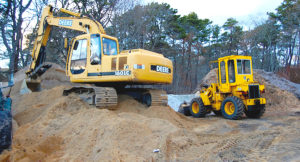
Even before planning begins, Edwards points out, it’s important to check with your town’s building department to find out what might be required, especially if you’re near wetlands or conservation areas — which is quite likely here on the Outer Cape.
Knowing the rules also helps you shape your vision for the property while abiding by regulations that protect the natural environment. It’s a process that must be dealt with, Edwards says, but it’s helpful. It’s better than developing a plan that can’t happen and that leaves you fighting the limitations of your land.
Let’s assume you got your project done by following those rules. Even so, Edwards says the post-construction terrain can still look disconcertingly bare and beat up. It can be tempting to just start planting. But it’s better to wait.
Thomas Edwards now works with his son Chad, who has an eye for landscaping. Chad’s advice is that early on you should try and determine how plants will function in your landscape. But even after construction or renovation has been done, it’s not too late to develop an overall vision for your property.
Start by considering your topography and soil. The best landscape designs will take these into account to promote moving water away from your house to preserve the foundation.
When it comes to larger trees, remember that it’s important to preserve some open space close to the house itself, Chad and Thomas say. Maintaining a 25-foot buffer for groundcovers and lower plantings will protect your house in a couple of important ways.
If your house doesn’t have room to breathe and dry out in the sunlight, then you’re just trapping moisture. And overhanging branches can cause mold spores to grow on the roof or can come down in storms and do damage.
A third step in planning the landscape is to take into account how the passage of time will affect your plantings. It’s important to give shrubs and trees enough room to reach their mature size.
“You can pretty things up as much as you want,” Chad says. But it is this type of site planning that helps you accomplish the ultimate goal of settling your home into the larger natural setting around you.
Thomas Edwards is from Provincetown and has been doing construction, landscaping, and site work for over 30 years. He now lives and works in Wellfleet, where he and his son Chad are the owners of T.A. Edwards & Son.
CLIMATE CRISIS
The Kids Aren’t All Right
Boomers boo from the stands as students protest inaction

The older generation has taken to saying how sorry it is to leave behind a climate crisis that young people will have to fix.
I’ve been the recipient of this condolence dozens of times. Family members, teachers, and politicians are full of regret: the boomers have made a mess that we must clean up. It has become a comfortable adage for enlightened older liberals. It compliments young people’s optimism and innovation. It acknowledges guilt.
But these words do little to soothe me. Instead, I feel deceived.
Under the guise of shame, this apology tacitly excuses adults in their prime from taking action. It suggests that the older generations are too stuck in their ways, too comfortable, and too tired to adjust their lifestyles or increase their political engagement. The use of the present tense — boomers are leaving a mess behind — implies they already have a foot out the door and, therefore, are unable to help. The future tense — kids will have to clean up — suggests that something must be done, but at some undetermined point in the future. It’s no wonder that the “Okay, boomer” retort has gone viral.
In reality, people between the ages of 50 and 80 wield immense power through financial, institutional, and social resources that young people cannot yet access. They determine environmental policy and greenhouse gas emission standards. They also have the experience and skills required to innovate solutions like mitigation technology. Therefore they must take action, precisely because they are older and in positions of influence.
I report on the environment and sustainability for the Independent. Every day at work, the climate crisis is in plain view, and the rate of change is staggering.
And yet I have been tempted to become complacent. Climate change feels farther removed from my daily life than it did a few years ago, when I was studying at Yale. As I left campus, started working, and accrued responsibilities, the world became less malleable. Without my radical peers and unable to forge a new system alone, I tried to fit myself into the preexisting one.
My capacity to be inspired, however, has not diminished. During the annual Harvard-Yale football game, when I watched student activists storm the field at halftime in a climate protest, my imagination loosened. The future was pliable again.
Students from Harvard and Yale jointly planned the protest, which delayed the football game by an hour. They chanted, held banners, and refused to leave, even under threat of arrest, demanding that the two universities completely divest from fossil fuels investments.
Older alumni booed the protestors from the stands. Although shaken by their dissent, I was not surprised. I now understand the responsibilities of adult life and the need to make “practical” decisions. But I do not mistake students’ activism for idealism.
Unlike previous generations, young people today are not afraid of a nuclear-armed political enemy. Rather, we fear a bomb that has already exploded. The climate crisis is inescapable, seems unpreventable, and has already arrived.
Older people might find it difficult to sympathize if they won’t be around to experience the worst effects of climate change.
But their lives may be affected more than they realize. Within the next two decades, 20 to 30 million more climate refugees will be in need of new homes. Aquifers that support farming in the Midwest will be almost completely depleted, threatening the food supply. Heat waves, which are particularly fatal for elderly people, will continue to intensify.
The youth have taken the football field, commanding attention and demanding to be heard. But we have not yet seized the referee’s whistle. Demonstrations do not equal power, and the institutions that can effect real change — from governments to university endowments — are still out of our hands.
Yale’s endowment managers control over 30 billion dollars. Their actions set an example for institutions around the world. As long as Yale believes that it’s fine to invest in fossil fuels — along with Puerto Rican debt, private prisons, and ammunition manufacturers — other investors, who hope to emulate Yale’s success, will also think those are smart investments.
Students can delay football games, make speeches, and cause disruption. But older folks must do more than praise young people’s activism. They must allow themselves to be inspired by it and believe that they too have the power to effect change. Our future is only as fixed as we imagine it to be.
VIEW FROM THE HIVE
In Winter, Bees Become a Superorganism
A strategy to conserve energy and food
Hive entrances are eerily vacant and quiet this frigid November morning, but an ear to the boxes reveals lots of life inside. A healthy cluster of wintering honey bees emits a low and steady hum — the sound of thousands of bee-muscle contractions, fueled by stored honey and generating heat to share.
Unlike our native social bees, which overwinter as solitary hibernating mated queens, European honey bees pass the winter in large colonies that are metabolically active. With the queen always in the center, the honey bee winter cluster shrinks and swells with falling and rising outside temperatures. In this way a healthy colony thermoregulates, maintaining a nearly constant central temperature in the 50s F, despite wild swings in air temperature and wind chill just inches away.

The coordination involved is intricate: bees in the center of the cluster do most of the heat generation, while others form an insulating shell around them. When these bold outside workers start to chill to a critical temperature, they save themselves by diving deep into the warm cluster’s interior, to be replaced by warm nestmates.
The strategy is to conserve fuel: 40 to 60 pounds of honey that a strong colony has stored for a flowerless Cape Cod winter. Honey bee scientists view those thousands of individual bees in the wintering cluster as a single organism, or “superorganism,” when it comes to the way thermoregulation works. Their studies have shown that the colony’s minimal metabolic rate, and maximum honey conservation, occurs at about 40 degrees. Below this temperature, honey consumption and heating must increase to prevent the entire cluster from freezing. Temperatures above the low 40s cause the bees to become more active and burn more energy.
Ever since the invasion of the parasitic mite (Varroa destructor) on Cape Cod in the late 1980s, maintaining honey bee colonies here through the fall and winter has gotten a lot more complicated. Gone are the halcyon pre-mite days when even incompetent beekeepers, so long as they left enough honey on the hives in the fall for the bees, could count on live colonies in the spring.
The problem is that until recently the western honey bee, Apis mellifera from Europe, and the varroa mite from Asia had never met, so the two haven’t had a long period of co-evolution to develop a happy or, rather, adaptive, host-parasite relationship. Mite infestations of honey bee colonies in North America are currently virulent and often lethal. Besides feeding on wintering bees’ fat and protein reserves, otherwise essential for the rearing of healthy bee offspring in late winter and spring, varroa mites transmit debilitating bee viruses.
Nature will eventually find a way for bees and mites to live together: some honey bees are already becoming more mite-resistant, and mites may become less virulent; it’s not smart for a parasite to kill its host. But in the meantime the successful beekeeper has to intercede.
When varroa mites first arrived on the Cape, many beekeepers turned to strong pesticides, but these stressed the bees, accumulated in beeswax and became ineffective as the mites fairly quickly developed resistance. Now there are more benign alternatives that rely on regular mite monitoring, complicated hive-management strategies, and the application of naturally occurring acids and essential oils that kill mites with less stress to the bees.
The need to manage varroa has made beekeeping a lot more work. The chance to see thousands of healthy worker bees bursting from the hives in spring makes it worth the effort.
ENVIRONMENT
A Mountain of ‘Sacrificial Sand’ Is Dumped at Blasch House
Coastal bank is replenished as property owners challenge town in court
WELLFLEET — The Blasch property is receiving another massive amount of “sacrificial sand” in an effort to stall the mansion’s collapse over the edge of a coastal bank.
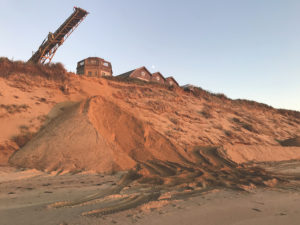
The 5,817-square-foot house perched on “the Gut,” a narrow spit of sand between Cape Cod Bay and the Herring River, was only 25 feet from the edge of the bluff one year ago. The owners, Barbara and Mark Blasch, are engaged in a legal battle with the town’s conservation commission, which last year denied them permission to erect a 241-foot stone seawall to shore up the coastal bank beneath their house.
The Blasches’ attorneys are appealing that denial in a case pending in Barnstable Superior Court. In the meantime, the owners are adding lots of sand to the cliff for the second time this year.
In January the conservation commission allowed them to add between 1,000 and 2,000 cubic yards of sand to the rapidly eroding bayside bluff. Last month the Blasches notified the town that they were going to dump a similar amount there. That work has begun, said Hillary Greenberg-Lemos, Wellfleet’s health and conservation agent on Tuesday.
The property owners have been adding sand there since 2013, when they first got permission to repair their beach stairway, add plantings, and renourish the coastal bank. The town did not impose limitations on the amount of sand. But 1,000 to 2,000 cubic yards is by far the most ever added at one time, Greenberg-Lemos said.
The sand is “sacrificial,” she explained, meaning it is being used to prevent further landward erosion. It is meant to be a temporary barrier that will be taken away by wave action.
Usually sand is added as part of the conditions to build a seawall. It replaces sand that would otherwise be available to the beach if there were no seawall in place, Greenberg-Lemos said. It’s also taken away by wave action but much more slowly.
Sand nourishment does serve a purpose, she said, though this particular use of it at the Blasch house is not typical.
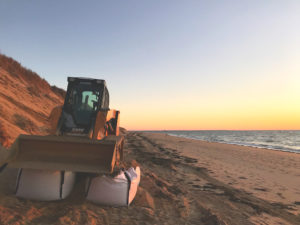
When members of the conservation commission received notice in October that the Blasches were bringing in more sand, they asked their representatives to attend the commission’s Nov. 6 meeting. The encounter was apparently contentious, said Greenberg-Lemos, though she was not in attendance.
But since the ConCom has not agreed to be video recorded by the town, there is an only an audio tape of the meeting. This was not available by the Independent’s deadline. And the members of the ConCom have refused to talk about the case because of the ongoing litigation.
Greenberg-Lemos said some members of the conservation commission are emotional about this particular project. The fact is, the town cannot stop the massive new sand infusion because there was never a limit on the amount of sand to be added; also the method of adding the larger amount of sand had already been approved in January.
As of last week there was a large vehicle acting as a conveyor belt shooting sand from the Blasches’ back yard to the bottom of the bank. And a small tracker loader was on the beach moving the sand around.
“It’s a more intense way of moving the sand” than the way Gordon Peabody did it for the Blasches back in 2013 when he just dumped it over the edge of the cliff, Greenberg-Lemos said.
The Blasch house is truly on the edge. In October 2018 engineer John Harrison warned the that the house was in danger of “complete collapse.”
The Blasches’ consultants told the ConCom that the house could not be moved because of the steepness of the property and the location of geothermal wells and a septic field, and because “there is not enough land to relocate the dwelling and maintain compliance with zoning setbacks and property line encroachments.”
ENVIRONMENT
Globe Brings Cape’s Climate Crisis to City Audience
A follow-up conference raises issues of equity, justice, and retreat from the coast
BOSTON — The Boston Globe’s multimedia reporting project “At the Edge of a Warming World,” published with much fanfare last month, held few surprises for Cape Codders. Most of it was old news — yes, we’re experiencing erosion, flooding, storms, and biodiversity loss. Species are shifting their ranges. Fish stocks are dwindling, and special habitats for migratory birds are at risk.
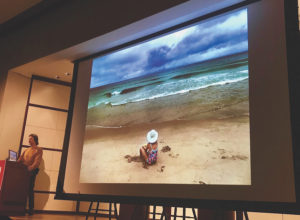
But the team behind the project say that they intentionally sought an outsider audience, gearing it to readers who visit Cape Cod only during the summer and leave their worries behind at the Sagamore and Bourne bridges.
To follow up on the report and spur action on its findings, the newspaper sponsored a conference of journalists, climate scientists, and civic leaders on Oct. 22 in Boston. Globe narrative editor Steve Wilmsen said that climate coverage often makes the crisis seem remote.
“A lot of stories felt far away in the future and left me with a feeling of powerlessness,” Wilmsen said. He argued that New Englanders don’t really relate to polar bears.
“This was our way to make a story that was not remote or abstract, but real and tangible and part of all of our lives,” he said. The journalists wanted to make the crisis feel personal for readers by showing their treasured spots for beach fires, kayaking, or fried clams threatened by sea level rise and erosion.
With the Cape’s evocative landscapes as a backdrop, the Globe team hoped readers would both grasp the crisis’s severity and feel empowered to take action.
The article, photos, and videos have been hugely popular among readers, said Globe editor Brian McGrory. On the first day of its web release, the story had over 100,000 hits, and readers lingered for 10 minutes on average — considered a lengthy stay for online engagement. The Boston event also drew a sizable crowd of close to 300.
Cape Codders also enjoyed the article. Globe columnist Nestor Ramos told the Independent that he was surprised by the number of positive reviews from locals.
“I wanted to let folks tell their stories,” Ramos said. He conducted interviews from May to September for the project. “It was critically important to be faithful to their experience of the place and capture also how beautiful it still is and how much we should treasure it.”
Shifts in climate typically do not appear as new phenomena. Instead, climate change affects already existing processes by, for example, accelerating rates of erosion or increasing the intensity of storms.
Therefore, it wasn’t simple to capture climate change on camera.
Globe photographer John Tlumacki said this was his most difficult assignment to date. He returned to Cape sites multiple times in search of the perfect shot.
Tlumacki ended his presentation at the conference with an image of a girl playing in the sand as a storm builds on the horizon.
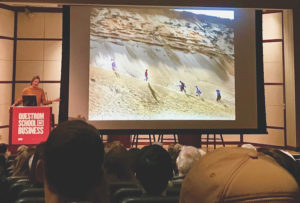
“I think I summed up climate change on Cape Cod in one photo,” he said. “We’re looking at present and future in the same photo. The threat of climate change is looming in the distance, but this girl doesn’t care. She just wants to have fun.”
Climate Justice and Equity
Other panelists discussed the implications of the Globe’s report.
State Sen. Julian Cyr of Truro said that, although Cape towns have been planning for climate change effects for years, the rate of change has been faster than anyone predicted.
“We have to make decisions today that we thought we’d make in 25, 50, or 100 years,” said Cyr. “Instead, we have to make those decisions in the next 5 to 10 years.”

In response to the article’s focus on coastal erosion and audience questions about sea walls, Cyr raised the issue of wealth inequity. Most local residents can’t afford to live on the edge of bluffs, he said, so protecting second homes of the wealthy is not his first priority.
“This is a place that has become profoundly unaffordable,” Cyr said. “Local folks are mostly living inland because that’s where the more affordable places are. Second, third, or fourth home owners often have this attitude: ‘I’m going to build that sea wall and not think about the repercussions.’ The adaptation that I’m focused on is not necessarily folks with homes on the coast.”
The issue of climate justice was also raised, primarily by students from Boston Latin School, who took the stage to briefly outline their responses to the article. Boston University Professor Cutler Cleveland pointed out that climate justice was not addressed until the very end of the event.
“The poor and people of color are disproportionately impacted [by climate change],” said Cleveland. “If you are not baking equity in at the very outset of your discussion, you’re ignoring it. And by definition it will get worse.”
The event concluded with a call to action.
Woods Hole Research Center senior scientist Linda Deegan said that people need to start showing up at select board meetings to demand that they take the climate crisis seriously. Deegan also pointed out that retreat from the coast will eventually be necessary.
Nationally, most flood insurance payouts cover the same five percent of buildings over multiple floods, Deegan said. “Clearly those are places that we shouldn’t be rebuilding,” she said. “We should limit the number of times you can rebuild in the same place after storm damage.
“Cape Cod is in a unique position to set an example for other parts of the U.S.,” Deegan concluded. “We’re on the cutting edge, the front line of climate change, and we have opportunities to change how people react to that.”
